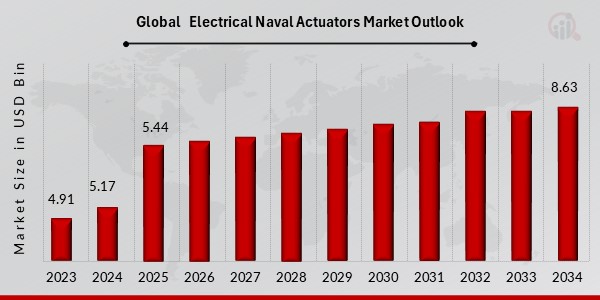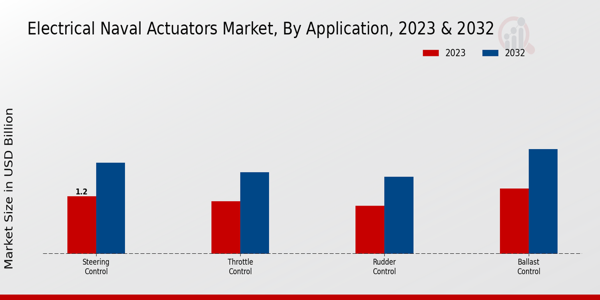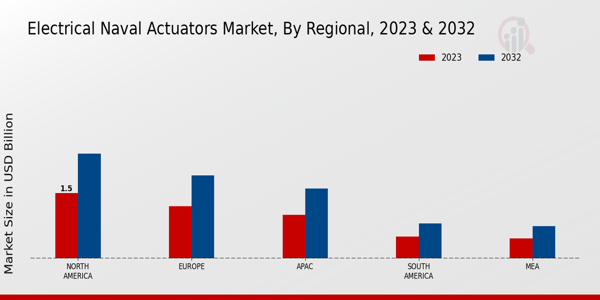Global Electrical Naval Actuators Market Overview
Electrical Naval Actuators Market Size was estimated at 5.17 (USD Billion) in 2024. The Electrical Naval Actuators Market is expected to grow from 5.44 (USD Billion) in 2025 to 8.63 (USD Billion) by 2034. The Electrical Naval Actuators Market CAGR (growth rate) is expected to be around 5.26% during the forecast period (2025 - 2034).

Source Primary Research, Secondary Research, MRFR Database and Analyst Review
Key Electrical Naval Actuators Market Trends Highlighted
The Electrical Naval Actuators Market is currently driven by the increasing demand for automation and energy efficiency in naval vessels. As militaries and commercial entities seek to enhance operational effectiveness and reduce environmental impact, electrical actuators are gaining traction due to their precision and reliability.
The push for digitization in defense technologies also plays a significant role in driving market innovations. Furthermore, growing investments in naval modernization and the adoption of advanced marine technologies are contributing to the market's expansion.
Opportunities in the Electrical Naval Actuators Market are plentiful, particularly as governments around the world focus on strengthening their naval fleets.
There is a notable trend towards developing smart and integrated systems that improve vessel maneuverability and responsiveness. The rising interest in electric propulsion systems also presents new avenues for growth as manufacturers look to design actuators that can seamlessly interact with these systems.
Additionally, the exploration of hybrid technologies may lead to a significant shift in how actuators are integrated into naval architectures. Recent trends show a noticeable shift toward sustainability within the market.
As environmental regulations tighten, there is a concentrated effort to create more eco-friendly actuator solutions. Advances in materials science and electrical engineering are paving the way for lighter, more efficient actuators that directly address these concerns.
Collaborations between manufacturers and technology developers are becoming more common, searching for innovative ways to integrate artificial intelligence and machine learning into actuation systems, which can lead to smarter, more adaptable naval operations in the future.
As the market continues to evolve, these trends and opportunities are set to shape the landscape of electrical naval actuators significantly.
Electrical Naval Actuators Market Drivers
Increasing Demand for Automation in the Naval Sector
The Electrical Naval Actuators Market is witnessing a significant uptick in demand for automation across naval vessels, which serves as a major driver for market growth.
The push towards automation is being fueled by the need for enhanced operational efficiency, safety, and reduced labor costs in maritime operations. Naval forces are incorporating advanced technologies that focus on automated control systems in ships, submarines, and other maritime platforms.
This trend is aligned with the broader industry movement towards digitalization and the Internet of Things (IoT), which further enables remote monitoring and management of actuators and control systems.
As naval forces globally seek to modernize their fleets with sophisticated technology, the integration of electric actuators provides a reliable and efficient solution for controlling various systems, including propulsion, steering, auxiliary systems, and weaponry.
Additionally, the reduction in maintenance costs associated with electric actuators, compared to traditional hydraulic systems, further enhances their appeal in new shipbuilding projects as well as retrofitting existing vessels.
Consequently, this growing automation in the naval sector not only boosts the demand for electrical actuators but also drives innovation in the Electrical Naval Actuators Market, encouraging manufacturers to develop advanced, efficient products that meet the strict requirements of naval applications.
Technological Advancements in Actuator Systems
Technological innovations are significantly accelerating the growth of the Electrical Naval Actuators Market. Advancements in material science and engineering have led to the development of lighter, more durable, and efficient electric actuators, which are ideal for naval applications.
These improvements reduce energy consumption while enhancing performance and reliability, making electric actuators a preferred choice over traditional solutions.
Furthermore, the integration of smart technologies into actuator systems, including sensors and automated feedback mechanisms, allows for more precise control and monitoring, ultimately contributing to improved operational capabilities in naval environments.
Growing Investment in Defense and Naval Modernization
Countries around the world are increasing their defense budgets, which is propelling growth in the Electrical Naval Actuators Market.
This investment is primarily directed towards the modernization of naval fleets to address contemporary threats and improve maritime capabilities. Governments are recognizing the importance of upgrading their naval assets, and part of this modernization effort includes integrating advanced electric actuator systems.
As navies expand and upgrade their fleets, the demand for efficient and reliable actuator solutions rises, further pushing the market forward.
Electrical Naval Actuators Market Segment Insights
Electrical Naval Actuators Market Application Insights
The segment revealed a diverse range of applications, each critical to the overall functionality and maneuverability of naval vessels.
Within this segment, Steering Control stood out with a valuation of 1.2 USD Billion in 2023, projected to increase to 1.9 USD Billion by 2032. The significance of Steering Control lies in its direct influence on a vessel's navigation and maneuverability, making it a crucial component in maritime operations.
Similarly, Throttle Control, valued at 1.1 USD Billion in 2023 and expected to reach 1.7 USD Billion in 2032, played a vital role in managing the engine power and speed of naval ships, further emphasizing its importance in enhancing operational efficiency.
The Rudder Control application, valued at 1.0 USD Billion in 2023 and anticipated to grow to 1.6 USD Billion in 2032, was essential for maintaining directional control of vessels, reinforcing its critical status in naval operations.
Meanwhile, Ballast Control was also notably significant, with a valuation of 1.36 USD Billion in 2023 that is expected to rise to 2.18 USD Billion by 2032.
This application was instrumental for maritime stability and safety, particularly in ensuring proper weight distribution to enhance the ship's performance.
The steady market growth in these applications is primarily driven by advancements in technology and the increasing demand for efficient naval operations. The continuous innovation in electrical actuators is fuelling market expansion, as it allows for greater reliability and performance in various naval applications.
However, challenges like high installation and maintenance costs can affect market penetration, presenting both hurdles and opportunities for new entrants and existing players in the Electrical Naval Actuators Market.
The overall segmentation of the market indicates a balanced growth trajectory across these applications, with Steering Control and Ballast Control holding the majority share and showing significant potential for growth in the coming years.
This structured growth within the Application segment is further supported by the rising need for modernized naval fleets, presenting a dynamic landscape for investment and development within the Electrical Naval Actuators Market.

Source Primary Research, Secondary Research, MRFR Database and Analyst Review
Electrical Naval Actuators Market Type Insights
The Electrical Naval Actuators Market is set to witness significant growth, driven by advancements in naval technology and increasing demand for automation in maritime operations. The market is segmented into various types, including Rotary Actuators, Linear Actuators, Multi-Turn Actuators, and Single-Turn Actuators, each contributing uniquely to the overall market dynamics.
Among these, Rotary Actuators hold a significant position due to their ability to provide precise motion control in various applications, making them essential for steering and control systems.
Linear Actuators are also crucial for applications requiring linear motion, showcasing their importance in lifting and positioning tasks within naval vessels. Multi-turn and Single-Turn Actuators play pivotal roles in operations requiring numerous rotations or limited rotations, respectively, catering to specific control needs in the naval sector.
The overall Electrical Naval Actuators Market data reflects a growing trend towards enhanced operational efficiency and reliability in naval operations, with significant opportunities for innovation and improvement in actuator technology tailored for marine environments.
The market growth is further supported by the rising demand for smart ships and automated systems, creating a conducive environment for the increasing adoption of electric actuators in naval applications.
Electrical Naval Actuators Market End Use Insights
The market encompasses diverse applications, with naval vessels, commercial ships, yachts, and leisure boats playing a pivotal role. Naval vessels represent a critical segment due to the increasing investments in modern naval fleets and advanced maritime defense technologies.
The commercial ships domain also showcases growth driven by the rising demand for efficient transportation and logistics services, further buoyed by evolving regulatory frameworks aiming at reduced emissions.
Yachts and leisure boats contribute significantly to the market, owing to a surge in recreational boating activities and associated luxuries. This segment tends to dominate market dynamics as consumer preferences shift towards more automated and environmentally friendly boating experiences, highlighting a trend toward digitization and sustainability in the Electrical Naval Actuators Market.
Overall, the market data indicates strong growth potential shaped by evolving consumer demands and technological advancements across all segments.
Electrical Naval Actuators Market Technology Insights
The segmentation within this market reveals critical categories, predominantly including Electromechanical, Electrohydraulic, and Electropneumatic technologies. Electromechanical systems are essential for their efficiency and reliability, providing precise control mechanisms crucial for naval applications.
Similarly, Electrohydraulic actuators play a significant role, particularly in high-force requirements, making them indispensable in modern naval engineering.
Meanwhile, Electropneumatic technologies also hold a valuable position, offering compact solutions that are widely used in various applications. Market trends indicate an increasing focus on automation and energy efficiency in naval operations, driving the demand for these technologies.
Despite the promising outlook, challenges such as high development costs and the need for skilled technicians remain prevalent. The potential for innovation and advancements in these technologies presents considerable opportunities for growth within the Electrical Naval Actuators Market.
Electrical Naval Actuators Market Regional Insights
The Electrical Naval Actuators Market is poised for stable growth, with the North American segment leading in valuation at 1.5 USD Billion in 2023, expected to rise to 2.4 USD Billion by 2032, thereby holding a significant portion of the market.
Europe followed closely with a value of 1.2 USD Billion in 2023, increasing to 1.9 USD Billion, reflecting its importance in the naval industry. The APAC region, valued at 1.0 USD Billion in 2023 and anticipated to grow to 1.6 USD Billion, signified emerging opportunities backed by increasing naval modernization efforts.
South America and MEA showed values of 0.5 USD Billion and 0.46 USD Billion in 2023, both projected to grow to 0.8 USD Billion and 0.74 USD Billion, respectively, indicating a slower growth rate yet potential for future developments in local naval capabilities.
The overall market showcased diverse dynamics, where regions like North America and Europe dominated due to established naval infrastructures, while APAC stood out for its rapid modernization, indicating varied opportunities and challenges across different regions contributing to the Electrical Naval Actuators Market revenue.
Source Primary Research, Secondary Research, MRFR Database and Analyst Review
Electrical Naval Actuators Market Key Players and Competitive Insights
The Electrical Naval Actuators Market is experiencing significant growth, fueled by advancements in automation and the increasing demand for efficient marine systems. In this highly competitive landscape, key players are focused on developing innovative technologies to enhance the performance and reliability of electrical actuators used in naval applications.
The market is characterized by a mix of established companies and emerging players, each striving to capture market share by offering cutting-edge products that meet the specific needs of the maritime sector.
Competitive insights reveal a dynamic environment in which companies invest heavily in research and development, aiming to introduce solutions that reduce energy consumption and improve operational efficiency.
Moreover, strategic partnerships and collaborations within the industry have become common as businesses seek to leverage complementary strengths and expand their market presence.
Wärtsilä is a prominent player in the Electrical Naval Actuators Market, widely recognized for its commitment to technological innovation and high-quality products. The company has established a strong market presence through its extensive portfolio of electrical actuation solutions designed for various naval applications, including propulsion systems and control mechanisms for vessel maneuverability.
Wärtsilä's strengths lie in its ability to integrate advanced automation technologies with reliable electrical actuators, allowing for enhanced vessel performance and reduced environmental impact.
The company's expertise in marine engineering and its strong network contribute significantly to its competitiveness in the market. Furthermore, Wärtsilä's dedication to sustainability aligns well with the industry's evolving demands, providing it with a competitive edge in meeting the growing requirement for eco-friendly naval solutions.
Parker Hannifin also plays a crucial role in the Electrical Naval Actuators Market, leveraging its extensive experience in motion and control technologies. The company is known for its innovative actuator systems that are tailored to marine applications, enabling precise control and efficient operation in challenging maritime environments.
Parker Hannifin's strengths include a robust product lineup that encompasses various types of actuators backed by significant investment in research and development to drive continuous improvement and innovation. The company's reputation for reliability and performance further enhances its market position, attracting a diverse clientele across the naval sector.
Additionally, Parker Hannifin's focus on developing solutions that meet regulatory standards for environmental sustainability resonates with industry trends, positioning it favorably within the competitive landscape of electrical naval actuators.
Key Companies in the Electrical Naval Actuators Market Include
- Wärtsilä
- Parker Hannifin
- Siemens
- GE Grid Solutions
- Rockwell Automation
- ABB
- Marine Technologies
- Honeywell
- Schneider Electric
- Thrustmaster
- Eaton
- Moog
- Kongsberg Gruppen
- CurtissWright
- Naval Group
Electrical Naval Actuators Market Developments
Recent developments in the Electrical Naval Actuators Market indicate a growing emphasis on technological advancements and sustainability. Companies such as Wärtsilä and ABB are investing in innovative solutions to enhance energy efficiency and optimize control systems for naval applications.
The market is also witnessing an increasing demand for electric actuators in response to naval modernization programs. Siemens and Parker Hannifin are focusing on expanding their product portfolios to include smart actuator solutions integrated with Internet of Things (IoT) technology, thereby improving operational capabilities and maintenance efficiency.
In mergers and acquisitions, Thrustmaster is reportedly exploring strategic partnerships to enhance its position in the market. Meanwhile, Kongsberg Gruppen has acquired technologies from Curtiss-Wright, strengthening its product offering in the naval sector.
As the market experiences growth in valuation, this uptrend is driven by heightened defense expenditures and a shift toward automation and digitalization across naval fleets.
Companies like Honeywell and Schneider Electric are also aligning their strategies to capitalize on emerging opportunities in the electric naval actuators segment, thereby impacting the overall market dynamics significantly.
Electrical Naval Actuators Market Segmentation Insights
- Electrical Naval Actuators Market Application Outlook
- Steering Control
- Throttle Control
- Rudder Control
- Ballast Control
- Electrical Naval Actuators Market Type Outlook
- Rotary Actuators
- Linear Actuators
- Multi-Turn Actuators
- Single-Turn Actuators
- Electrical Naval Actuators Market End Use Outlook
- Naval Vessels
- Commercial Ships
- Yachts and Leisure Boats
- Electrical Naval Actuators Market Technology Outlook
- Electromechanical
- Electrohydraulic
- Electropneumatic
- Electrical Naval Actuators Market Regional Outlook
- North America
- Europe
- South America
- Asia Pacific
- Middle East and Africa
Electrical Naval Actuators Market Report Scope
| Report Attribute/Metric |
Details |
| Market Size 2024 |
5.17 (USD Billion) |
| Market Size 2025 |
5.44 (USD Billion) |
| Market Size 2034 |
8.63 (USD Billion) |
| Compound Annual Growth Rate (CAGR) |
5.26% (2025 - 2034) |
| Report Coverage |
Revenue Forecast, Competitive Landscape, Growth Factors, and Trends |
| Base Year |
2023 |
| Market Forecast Period |
2025 - 2034 |
| Historical Data |
2019 - 2023 |
| Market Forecast Units |
USD Billion |
| Key Companies Profiled |
Wärtsilä, Parker Hannifin, Siemens, GE Grid Solutions, Rockwell Automation, ABB, Marine Technologies, Honeywell, Schneider Electric, Thrustmaster, Eaton, Moog, Kongsberg Gruppen, CurtissWright, Naval Group |
| Segments Covered |
Application, Type, End Use, Technology, Regional |
| Key Market Opportunities |
Increased defense spending globally, Growing demand for automation, Expansion of naval fleet modernization, Technological advancements in actuator systems, Rising maritime security concerns |
| Key Market Dynamics |
Increasing naval modernization programs, Growing demand for energy efficiency, Rising electronic warfare capabilities, Advancements in actuator technologies, Expanding military expenditures globally |
| Countries Covered |
North America, Europe, APAC, South America, MEA |
Frequently Asked Questions (FAQ) :
The Electrical Naval Actuators Market is expected to be valued at 8.63 USD Billion by 2034.
The expected CAGR for the Electrical Naval Actuators Market from 2025 to 2034 is 5.26%.
The Ballast Control application segment is projected to have a market value of 2.18 USD Billion in 2032.
The North American region is expected to have a market value of 2.4 USD Billion by 2032.
Key players in the market include Wärtsilä, Parker Hannifin, Siemens, and GE Grid Solutions, among others.
The Throttle Control application was valued at 1.1 USD Billion in the year 2023.
The Rudder Control application segment is expected to be valued at 1.6 USD Billion by 2032.
The Electrical Naval Actuators Market was valued at 4.66 USD Billion in 2023.
The European region is projected to have a market value of 1.9 USD Billion by 2032.
The APAC region was valued at 1.0 USD Billion in the year 2023.

















